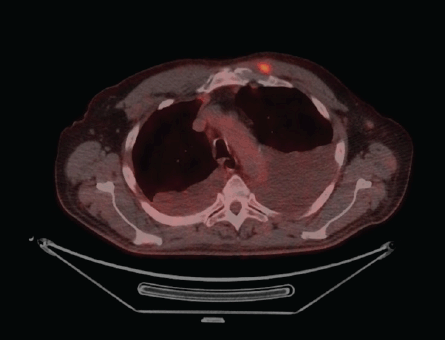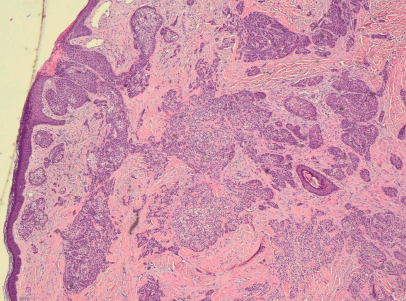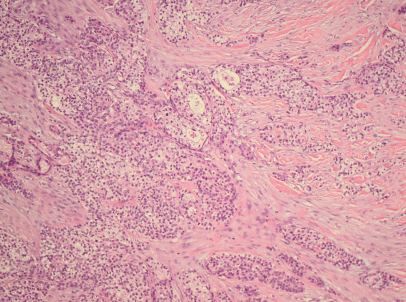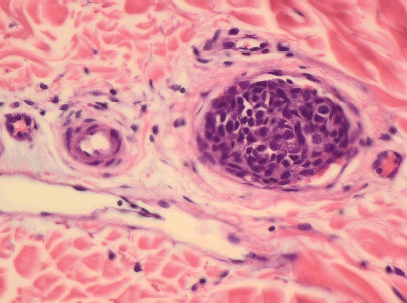A rare case of clear cell Hidradenocarcinoma presenting with recurrent pleural and cardiac effusion
Camilla Engelsmann1, Gitte Wooler2,3, Vladimira Horvat4 and Shailesh Balasaheb Kolekar1,5
1Department of Medicine, Zealand University Hospital, Roskilde 4000, Denmark
2Department of Histopathology, Copenhagen University Hospital – Herlev and Gentofte, 2730, Denmark
3Department of Clinical Medicine, University of Copenhagen, Copenhagen 2000, Denmark
4Department of Oncology, Roskilde University Hospital, Roskilde 4000, Denmark
5Copenhagen University, Copenhagen 2000, Denmark
Abstract
Clear cell hidradenocarcinoma (HAC) is a rare and aggressive malignant tumour originating from eccrine sweat glands, accounting for only 0.001% of all tumours. HAC primarily occurs in the head and neck region, with a high propensity for local recurrence and distant metastases. This case report details the unusual presentation of a 66-year-old male with a history of myocardial infarction, hypertension and a significant smoking history, who presented with abdominal pain and progressive shortness of breath. Diagnostic imaging revealed pleural and pericardial effusion and initial workup, including biopsies from pleura, skin and lymph nodes, was inconclusive. Subsequent histopathological examination suggested a diagnosis of HAC with metastases to the pleura, pericardium, lymph nodes, bones and subcutaneous tissues. Despite aggressive diagnostic efforts, the patient succumbed to the disease before chemotherapy could be initiated. This case underscores the diagnostic challenges of HAC, particularly with its atypical presentation and rare metastatic sites, such as the pleura and pericardium. The report emphasises the need for awareness of this rare malignancy and its potential for rapid, fatal progression.
Keywords: clear cell hidradenocarcinoma, hidradenocarcinoma, sweat gland tumour, skin tumours, metastasis
Correspondence to: Camilla Engelsmann and Shailesh Balasaheb Kolekar
Email: Camilla.engelsmann@gmail.com and sbko@regionsjaelland.dk
Published: 19/08/2025
Received: 18/02/2025
Publication costs for this article were supported by ecancer (UK Charity number 1176307).
Copyright: © the authors; licensee ecancermedicalscience. This is an Open Access article distributed under the terms of the Creative Commons Attribution License (http://creativecommons.org/licenses/by/4.0), which permits unrestricted use, distribution, and reproduction in any medium, provided the original work is properly cited.
Introduction
Clear cell hidradenocarcinoma (HAC) is a rare and aggressive eccrine tumour of the sweat glands. It accounts for 0.001% of all tumours [1–4] and 6% of eccrine tumours [2, 5, 6]. Studies suggest a higher prevalence in males compared to females [1, 2, 7]. HAC most commonly debuts around the age of 50–70 years; however, cases in children have been noted [4, 5, 7, 8]. HAC is most commonly found in the head and neck area, but is rarely, seen on the trunk, gluteal area and extremities [1, 2, 4, 7, 9]. It usually arises de novo and rarely from preexisting hidradenomas [10]. Distant metastases are seen in 39% of cases [7]. Most commonly, HAC metastasises to the lymph nodes, but metastases have been seen in multiple organs such as lungs, pleura, liver, bone, including vertebrae and bone marrow [1, 3–5, 8, 9]. Post-surgical recurrence is common and is seen in 60 % of cases. Five-year post-surgical survival is only 30% [3–6].
We present a case of multiple metastases of HAC with a rare presentation where diagnosis proved difficult, and the outcome was fatal.
History
A 66-year-old male with a history of myocardial infarction, hypertension and a smoking history of 25–30 pack-years, presented to his primary care physician with abdominal pain. He later admitted to 3 weeks of progressive shortness of breath.
An ultrasound of the abdomen showed no intraabdominal pathology but found pleural effusion. The patient was referred for a chest X-ray, which showed fluid in both the pericardium and pleura bilaterally. Computed tomography (CT) of the thorax and abdomen showed 3 cm pericardial effusion, pleural effusion and was suspicious of malignant mesothelioma with metastases to the subcutis of the truncal skin and left pectoral muscle.
Later, a positron emission tomography (PET)-CT scan showed increased 18Fluor-Deoxy-Glucose uptake in the rod of the tongue, lymph nodes on the neck, tumours in the truncal subcutis and left pectoral muscles. The PET-CT also suggested metastasising to the bones, flank and gluteal area (Figures 1 and 2). Initial tests also included diagnostic examinations of the pleural fluid and a pleural biopsy and the patient was referred to the department of Otorhinolaryngology Head & Neck Surgery, where a laryngoscopy was performed with biopsies from the base of the tongue and biopsies from cervical lymph nodes (Figure 3). Mesothelial hyperplasia was found in the pleural fluid and the histopathological patterns from the lymph node biopsy suggested an adnexal tumour, presumed to be HAC; however, it could not rule out squamous cell cancer or a possible metastasis.
A magnetic resonance scan showed tumour growth into the mastication muscles. The patient then underwent an oropharyngoscopy with multiple re-biopsies from the tongue, never finding signs of malignancy.

Figure 1. PET- CT with FDG uptake in a metastasis of the left pectoral muscle.

Figure 2. FDG PET increased uptake of FDG in the root of the tongue.

Figure 3. Hypoechoic conglomerate at lvl. 2–3 on the right side of the neck suggesting lymph node conglomerate.
Later, a biopsy from a tumour in the pectoral muscle was performed; however, it was not possible to get a sufficient amount of tissue for diagnosis. A video-assisted thoracoscopy biopsy of the right parietal pleura was performed with no clear diagnosis. At the same time, a re-excision of the tumour in the pectoral muscle was performed and showed carcinoma metastasis from an unknown tumour. Afterward, the patient was referred to a dermatologist for excision of the truncal subcutaneous tumour (Figures 4–6), and the pathological diagnosis suggested a HAC
in the skin, denying suggestions of metastasis originating from the lung or pleura or clear cell carcinoma of the tongue, as first believed. Later histopathological patterns from another lymph node biopsy supported this diagnosis.
Because of fast-developing pleural- and pericardial fluid, the patient had more than 14 pleurocenteses and multiple pericardiocentesis during diagnostic evaluation.
The patient was referred to chemotherapy at Rigshospitalet, Copenhagen Denmark, but died less than 3 months after initial referral before receiving any treatment.

Figure 4. Skintumour in close contact with an adnexal structure.

Figure 5. Area of tubular structure.

Figure 6. Area of vascular invasion.
Discussion
Clear cell hidradenocarcinoma is a rare and aggressive tumour, that arises from the intradermal duct of eccrine sweat glands. Microscopical analysis of HAC varies, but most commonly it shows a dermal-based neoplasm with ductal structures, intracellular lumen formation, variable clear cell changes and an infiltrative growth pattern [7].
Usually, HAC originates in the head and neck area. HAC is known to metastasise to lymph nodes and visceral organs [1, 3, 5, 8, 9]. Usually, patients present with a tumour of the skin in the early stages [9], and no other symptoms. In this case, the patient presented with abdominal pain and shortness of breath, and later diagnostic imaging showed metastases to multiple organs.
Initial biopsies from both the pectoral tumour, lymph nodes on the neck of the tongue either showed no malignancy or a metastasis of an unknown primary tumour. Later skin excision from the left pectoral area showed carcinoma with an expansive front, ductal structures, cells with intracellular laminae, high levels of mitosis, cells with light eosinophilic cytoplasm and clear cells, suggesting HAC as the primary diagnosis (Figures 4–6).
The patient presented with metastasis to lymph nodes, visceral- and pleural metastases and multiple skin tumours. Only a few cases of metastases to the pleural wall have been described in English literature [3, 5, 8], but multiple cases describe metastases to the lungs and lymph nodes [1, 3–5, 9].
At first, the conclusion of the multi-disciplinary team was that the patient suffered from clear cell adenocarcinoma (CCC) of the tongue. CCC of the tongue is a rare tumour that has been known to metastasise to the lungs [11] and rarely to the skin [12]. However, in this case, no biopsies from the tongue or other metastases suggested CCC, while two biopsies from different locations suggested other differential diagnosis: HAC.
Conclusion
The case presents a rare and aggressive form of HAC with unusual metastatic spread and provides valuable insight into the diagnostic challenges. By comparing HAC with other conditions like CCC, the case highlights the complexity of diagnosing rare tumours.
List of abbreviations
HAC, Clear cell hidradenocarcinoma; CT, Computed tomography; PET, Positron emission tomography; SCC, Squamous cell cancer; MR, Magnetic resonance scan; CCC, Clear cell adenocarcinoma.
Acknowledgments
No acknowledgements.
Conflicts of interest
No conflict of interest.
Funding
No funding was received for this study.
Informed consent
Informed consent was obtained and an informed consent form was filled out.
Author contributions
All authors have contributed to this article.
References
1. Korbi S, Rachdi H, and El Benna H, et al (2020) Objective clinical and radiological response under sunitinib in a case of thigh hidradenocarcinoma Case Rep Oncol Med 2020 1–3
2. Terzić Z, Paunovic M, and Popovic A, et al (2023) Transformation of recurrent hidradenoma into a metastatic hidradenocarcinoma in a 31-year old female patient Postepy Dermatol Alergol 40(6) 820–823 https://doi.org/10.5114/ada.2023.133588
3. Soni A (2015) Current Management Approach to Hidradenocarcinoma: A Comprehensive Review of the Literature ecancermedicalscience [Internet] 9 [http://www.ecancer.org/journal/9/full/517-current-management-approach-to-hidradenocarcinoma-a-comprehensive-review-of-the-literature.php] Date accessed: 09/07/24
4. Martins D, Pereira F, and Azevedo R, et al (2022) Eccrine hidradenocarcinoma of the scalp Cureus 14(3) e23023 PMID: 35419234 PMCID: 8994172
5. Gauerke S and Driscoll JJ (2010) Hidradenocarcinomas: a brief review and future directions Arch Pathol Lab Med 134(5) 781–785 https://doi.org/10.5858/134.5.781 PMID: 20441512
6. Zorro S, Matias R, and Sousa C, et al (2023) Malignant Transformation of Retroauricular Hidradenoma in Hidradenocarcinoma in a Nine-Year-Old Patient: A Case Report. Cureus [Internet] [https://www.cureus.com/articles/141034-malignant-transformation-of-retroauricular-hidradenoma-in-hidradenocarcinoma-in-a-nine-year-old-patient-a-case-report] Date accessed: 19/07/24
7. Kent S, Jeha GM, and Qiblawi S, et al (2024) Hidradenocarcinoma: a case series from the scripps clinic with a systematic review of the literature Dermatol Surg 50(6) 507–511 https://doi.org/10.1097/DSS.0000000000004140 PMID: 38460197
8. Chow CW, Campbell PE, and Burry AF (1984) Sweat gland carcinomas in children Cancer 53(5) 1222–1227 https://doi.org/10.1002/1097-0142(19840301)53:5<1222::AID-CNCR2820530533>3.0.CO;2-A PMID: 6318962
9. Wang XX, Wang HY, and Zheng JN, et al (2014) Primary cutaneous sweat gland carcinoma J Cancer Res Ther 10(2) 390 https://doi.org/10.4103/0973-1482.136667 PMID: 25022402
10. Shanmugam G, Chidambaram B, and Princess Beulah D, et al (2021) Malignant adnexal tumour of the shoulder-a rare case report J Surg Case Rep 2021(4) rjab025 https://doi.org/10.1093/jscr/rjab025 PMID: 33884163 PMCID: 8046015
11. Desai A, Faquin WC, and Iafrate AJ, et al (2022) Clear cell carcinoma: a comprehensive literature review of 254 cases Int J Oral Maxillofac Surg 51(6) 705–712 https://doi.org/10.1016/j.ijom.2021.03.018
12. Abou Shaar R, Zia S, and Alhamar M, et al (2021) Salivary gland hyalinizing clear‐cell carcinoma with cutaneous metastasis: a rare and deceptive tumor J Cutan Pathol 48(1) 86–89 https://doi.org/10.1111/cup.13799





